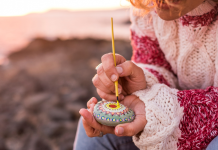 Growing up, one of my favorite parts of the week before Easter was rushing home from school to find my mom and grandmother boiling dozens of eggs for us to color. I loved sitting there for what felt like hours waiting for my eggs to turn the perfect shades of bright pink, blue, or yellow.
Growing up, one of my favorite parts of the week before Easter was rushing home from school to find my mom and grandmother boiling dozens of eggs for us to color. I loved sitting there for what felt like hours waiting for my eggs to turn the perfect shades of bright pink, blue, or yellow.
Now that I have a toddler of my own, I want to share the tradition with my family — minus all the artificial colors.
So here is how to make your own vibrant all natural Easter egg dye with vegetables and spices. You may even already have most of the ingredients you’ll need in your kitchen or pantry.
Make your own natural Easter egg dye
When I first heard about making natural food dyes at home, I imagined it would be complicated, time-consuming, and downright messy. Who would want to do something like that with toddlers underfoot?
But thankfully, I couldn’t have been more wrong! It’s a breeze to make safe and natural dyes at home.
Pick your natural color ingredients
First, before getting started, you’ll need to choose what color dyes you want to make. Different vegetables, fruits, and spices can yield a rainbow of natural colors. So let your imagination run wild and experiment with what you already have at home.
Here are some suggestions to get you started:
- Yellow – 2 teaspoons ground turmeric
- Blue – 2 cups chopped red/purple cabbage (Roughly ½ cabbage)
- Pink – 2 cups shredded beats (Roughly one medium beat)
- Red – At least 2 red onion skins
- Orange – At least 2 yellow onion skins
Prepare your natural Easter egg dyes
After you’ve picked what colors you’d like to make, it’s time to start making your dyes.
First, gather your supplies:
- A medium saucepan
- Your prepared produce or spices
- Water
- White vinegar
- Optional: Airtight containers to store your dye
Next, follow these 6 easy steps:
- Add 2 cups of water and your prepared ingredients to a medium saucepan.
- Bring the mixture to a boil and let simmer, covered, for 15-30 minutes
- The longer your ingredients simmer, the brighter your natural colors will be.
- Remove your pan from the heat source and let it stand for 60 minutes.
- Using a fine mesh strainer, strain your dye into your airtight containers.
- Add 2 tablespoons of white vinegar to each color.
Protip: Out of vinegar? No problem! You can substitute 2 tablespoons of lemon juice for the vinegar in this recipe. Just add your lemon juice during step 1 and boil with your ingredients.
Color your Easter eggs
Once your homemade dyes have cooled to room temperature, it is time to start coloring your eggs. Allow each egg to sit in your homemade mixture for at least 30 minutes for the best results.
Remember that just because these dyes are natural does not mean they won’t stain clothes, furniture, or even little fingers. Use a plastic tablecloth or newspaper to prep your dyeing surface before beginning, and remember to have littles wear clothes you won’t mind sporting a few new stains.










[…] and I were talking about Easter and deciding what we need for the kids. Each year we typically do Easter baskets and a small egg hunt – super manageable and enjoyed by all. But this got us chatting […]